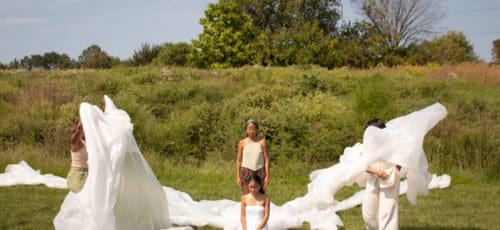Ticcing the Stage: A Conversation with Sutie Madison
“There’s something very primal about Tourette Syndrome,” says Sutie Madison, an artist and the impresario and director of the 2012 Philly Fringe show Tourettes: A Dancing Disorder.
According to the National Institutes of Health, Tourette syndrome is “a neurological disorder characterized by repetitive, stereotyped, involuntary movements and vocalizations,” more commonly, and collectively, called tics. Sutie herself has Tourette’s and is working to transform the movement of tics into a kinesthetic language.
“There’s something very surreal about having Tourette’s in general. You don’t see people doing stuff like this,” Sutie says, repeating one of her tics for me, in the crowded Center City coffee shop where we’re talking. “The show is about sharing and celebrating the surreal quality, and allowing people to take a look at the qualities of Tourette’s, and just stare at us. We allow people to look, to stare, to give the audience that gift.”
At the same time she wants to introduce audiences to the mundane surreality of life with Tourette’s, Sutie is trying to make a performance that isn’t only about the mundane.
“The work is a combination of art and science, at the intersection of research and creative expression. We use tics from medical footage, study the movements, and use them as the foundation for the choreography.”
After the jump: training performers to tic, and turning tics into art.
Sutie studied painting at Arcadia University, where she received her bachelor of fine arts in painting. But she wasn’t feeling satisfied with painting alone. So, she asked, “How can I use my Tourette’s as an art form? Painting just isn’t kinetic enough, so what if I just used the Tourette’s as the art? For the first one, I filmed myself in the basement, ticcing.” These Sutie has published as “The Twitch Trials.”
One of her professors at Arcadia, Alan Powell, saw what she was doing and suggested that she teach her tics to dancers, and design a performance piece. There’s also a scientific lecture about Tourette’s that occurs in the middle of the show, which Sutie hopes will push the performance beyond simply presenting avant-garde dance, and will bear fruit for researchers.
“This kind of thing could be beneficial to patients with Tourette’s. It creates opportunity from what can be seen as a disadvantage. Second, I’m starting to think that Tourette Syndrome is a form of kinesthetic intelligence, like a personal language system. These movements are a way of measuring space around you. It’s like my body’s radar for what’s going on around me,” Sutie says.
At workshops, Sutie stands in a circle with her dancers, and will show them a new tic. She shows me one: first, she brushes her eyebrow with the back of her hand, moves her hands, brings them together, pushes them out, and comes out with a bark. She explains:
“First I close my left eye, open my right eye, and find a spot on the ceiling. But I have to find a spot that’s not really a spot. Then I flick my eyebrow, look away, close my eyes, open my eyes, and seek the spot I looked for before,” says Sutie.
“I explain the OCD [obsessive-compulsive disorder] feelings that accompany Tourette’s. The performers say its so annoying, and hard to do. They get the challenges. I want them to feel it, to feel their own tic too. They’ve been very interested in learning about Tourette’s. During rehearsals, I’ll catch them ticcing, empathizing with the feeling.”
The social world for those with Tourette’s can be strange to navigate. “Sometimes I try to fit in,” Sutie says. “I can control it a bit. But sometimes I’ll force myself to do it anyway and make a spectacle. It’s both horrifying and exhilarating. The dancers relate, and I think anybody can relate to it. The common thread with people with Tourette’s is to play with danger.”
“Tourette Syndrome has become a big part of my identity, which is both good and bad. I’m glad to put a positive spin on it. Tourette’s is physically and mentally draining. It’s hard to live with. But in the end, I wouldn’t push a button to get rid of it. It’s taught me so much about empathy and being a kind person. I think we have to evolve ourselves spiritually, and Tourette Syndrome is a vehicle to propel me through that. That’s why I want to tell everybody and talk to people. I’ve finally found my voice in art, and it’s exactly what I’m doing” she says.
“I had wanted to be a dancer when I was very young, but even now I’m not really dancing so much. I have ideas I want to explore with Tourette’s. It’s not working in a traditional way, and part of why I feel it’s so suited to the Fringe.”
Sutie says she’s not currently pursuing painting, but with good cause. “I dumped it like a bad boyfriend. I found the love of my life, so all my stuff has gone into this mission. I feel very driven by this thing, even if I’m not sure what I’m doing.”
Tourettes: A Dancing Disorder runs September 7 and 8 at the Painted Bride Arts Center in Old City, and September 14 and 15 at the Spruance Fine Arts Center at Arcadia University in Glenside. All shows 8:00 pm, $15.
–Nicholas Gilewicz



